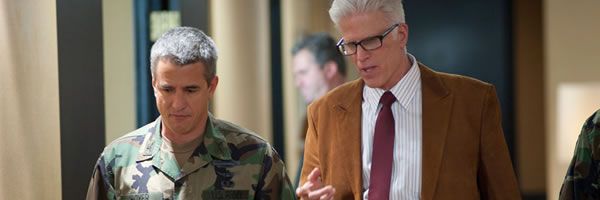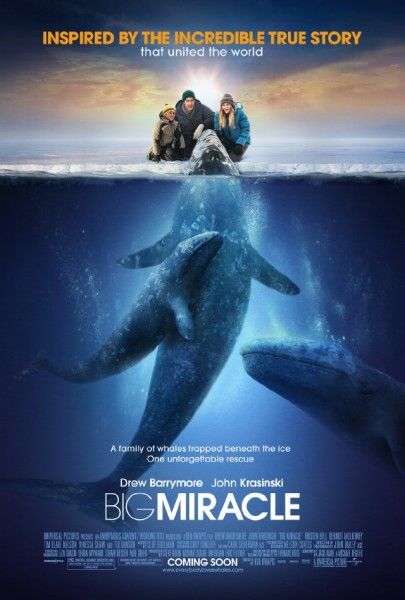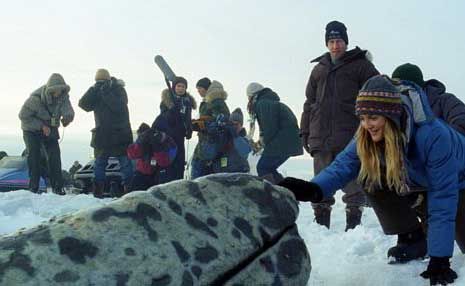Big Miracle (opening in theaters on February 3rd) is inspired by the incredible true story of a family of majestic gray whales trapped by rapidly forming ice in the Arctic Circle, and how an entire Alaskan community fought to save them, with the help of rival world superpowers. For the film, Ted Danson, who is a real-life advocate for cleans oceans and safe water practices worldwide, took on the role of stanch anti-environment businessman J.W. McGraw, while Dermot Mulroney took the honor of portraying Alaska National Guard commander Col. Scott Boyer, based on real-life hero Tom Carroll.
At the film’s press day, the co-stars talked about how playing characters based on real people inspired their performances, that whale meat doesn’t actually taste like chicken, how they dealt with spending so much time in such cold temperatures, and how impressed they both were with the challenges that director Ken Kwapis took on with this film. Check out what they had to say after the jump:
Question: In playing real people, did you want to actually meet them?
TED DANSON: Well, sadly, [Dermot’s] character passed away. My character was in jail. So, we didn’t meet them.
DERMOT MULRONEY: I had the fortune, however, of working closely with Bonnie Carroll, who’s the woman that Vinessa Shaw plays. Through her, I got a lot of invaluable information on the man I was playing and their relationship and how it began. Across a continent and over time, it was an epic romance.
Did that inform how you and Vinessa Shaw worked together?
MULRONEY: It did, very much. I was working with a great, skillful actor, which is the first thing you need. But, there was an intensity to that love that we were seeing firsthand, working with Bonnie. So, it began to feel more and more like a privilege to be portraying this man. In fact, I came to know some people in the community around Anchorage, and [Tom Carroll] was well known, socially. He was the father of that wing of the Air National Guard, so he was the premiere pilot, in that era, in Alaska and trained a lot of the guys that were actually up in those sequences, especially around the military equipment. He’s still a strong presence in Alaska.
DANSON: We went up to the Air National Guard to give something back and entertain the troops. We got there and we outnumbered the troops because they were off on maneuvers.
Ted, what was it like to play an oil company executive when you have your own environmental organization?
DANSON: I started doing the environmental ocean advocacy work about 25 years ago, and what I started merged into what is now Oceana, which is the largest international ocean advocacy group. I started off fighting off-shore drilling. Shell was wanting to open up the Beaufort Sea to offshore oil drilling, when we were shooting up there. I became friends with a lot of the people in the oil business because you bump into them, and you may be on different sides of the fence, but they’re really nice people, doing jobs we’re basically asking them to do, as a society. So, it wasn’t so hard for me to play this part, at all. My guy actually ended up in jail for doing some not-so-nice things, so I felt like I had carte blanche to make him as silly as I wanted.
Have you seen progress, in the 25 years that you’ve been doing environmental work?
DANSON: You will always have the fight for the need for more energy, with dwindling resources and trying to balance the environment. I think more people are educated about it.
Did you ever talk to Drew about her animal advocacy?
MULRONEY: All that did for Drew was prevent her from eating the whale meat that Ted and I went ahead and had.
DANSON: A little goes a long way!
What’s it taste like?
MULRONEY: It tastes terrible!
DANSON: It tastes, over and over again.
MULRONEY: You know how they say that it all tastes like chicken? This would, if you took a chicken and held it under the water in the ocean, for several decades, near an oil spill, and you let it rot, and then you cut off some of its flesh. It comes in these cubes that are black on one side, which is the flesh, and white on the other, which is the fat. They just pop it [in their mouths], and it’s really foul. It was provided fresh for us, from the Native Americans that were working on the film. They had it shipped in and it was like this delicacy had arrived on the set. Drew was a little scarce, at that moment, with her puppies and the whales.
How did you deal with spending so much time in those temperatures and environments, during filming?
MULRONEY: It’s so funny, I think cold is one of those things that you can’t really remember, so you can’t really grasp that sensation when you’re reflecting on it. I actually did another film in between The Grey and Big Miracle, so when Big Miracle wrapped, I stayed in Anchorage and did a film with Jon Voight, called Beyond, which is still being worked on. I finished that right after Thanksgiving, and then started The Grey on January 2nd. They were literally back-to-back, strung together, all in Alaska and all shot in sub-zero temperatures. But, I don’t remember being cold, ever. I know I must’ve been, but I was never miserable or huddled, hoping to get off the set or out of the conditions. You’re mentally prepared. Really, the stuff we did in [British Columbia] on The Grey was the coldest I’ve ever been. If you ever found yourself in those circumstances, you would either die or go inside.
DANSON: I, on the other hand, had it on the call sheet and in my contract that, if it’s below 32, you don’t call me.
Did you guys spend any time hanging out together, during your downtime?
DANSON: We did because we were each other’s extras. I would have three lines on Monday and wouldn’t speak again until Wednesday, but I was still standing next to Dermot, or somebody. There was 30 or 40 of us out on the ice, at the end of the movie, all playing background atmosphere to whoever’s scene it was that day.
MULRONEY: The way they scheduled the movie, logistically, was that we would do more or less the bulk of one storyline and then move to another story, depending on the order of the locations. Towards the end of the shoot, we all wound up working together. A lot of times on a film, you don’t even meet the other people that are in that cast. You’re just in the movie together, but your scenes don’t cross. This was one of those rare occasions where everybody was working, so we bonded over the adventure we were having, and over the conditions, and over the food, like you would in one of those situations where really different people are thrown into a common circumstance.
What was Ken Kwapis like, as director, especially with all of the various challenges on this film?
MULRONEY: I never saw Ken have any trouble. He has this amazing sense of calm that he brings to the set, so everybody’s confident and warm with one another.
DANSON: He’s the most prepared person I’ve ever met.
MULRONEY: I was so impressed, just with the logistics alone. He was dealing with that many people in the cast, and with temperature conditions and outdoor sets.
DANSON: We had two football fields’ length of ice that he built, so you could cut holes and there would be water underneath, so that you could put the whales underneath that. Then, he had to stick those two football fields in a plate of Barrow, Alaska. It was really complicated, figuring out how to blend the real with what would be computerized later. He was so prepared and so calm, and he also knew what he wanted so much that he allowed you to play and explore. It was a really relaxed set, thanks to him.
How did the Alaskan locals react to you filming there?
MULRONEY: It was really interesting. Anchorage is a great place, and the Alaskans are as fiercely loyal to their city as anyone I’ve met in this country, so hats off to them. Some of it was shot right in downtown Anchorage, so that was front page news in Anchorage, as it would be wherever. They not only enjoyed having us there, they just literally opened their doors to us. I knew someone who knew someone whose mother was then inviting me over for dinner at their house. I think that’s just how they do it, up there. At that dinner, I learned that they knew the guy that I was playing, so that was a coincidence. In the movie, they call the whales Fred, Wilma and Bam-Bam. At the time, from the Iñupiat point-of-view, the joke was that they were calling the whales Breakfast, Lunch and Dinner. So, you learn a little more backstory. People remember that story, in that part of the world, like it was yesterday. It’s all crystal clear to where they were when they first saw that footage.
Is playing a real person more of a challenge than playing a fictional character?
MULRONEY: I think this was more of a challenge because I wanted to honor him. He was really – not only in this circumstance, but in others that I’d heard of – truly a hero. I had gotten to know his widow, so it took on greater meaning for me, in terms of that. And, I had the privilege of working with Vinessa, in that storyline, so I think we did him right. In fact, the fur-lined parka that Vinessa wears in the film is Bonnie’s. She wore it that coat during the time when she finally left D.C. and went to Alaska. That’s the coat she brought with her. She still had it, and she gave it to Vinessa as a piece of the wardrobe.
DANSON: I’m almost tempted, when I’m playing a real person, not to meet them. Afterwards, maybe. But, the job is the same. You still have to show up on screen and be alive and real, and all that stuff. It’s a great story because it really is an Alaskan story, too. The beauty is just astounding there. And you have oil there, and almost everybody and their uncle works for the oil company. Then, you have the Iñupiat Indians, who get to harvest whales. There are religious and spiritual cultures based on whaling. And then, you have Shell wanting to drill off-shore. It’s the whole complex question of, “How do we live today with our environmental resources dwindling? How do we sustain ourselves with energy?” All of those questions were being faced and dealt with in this movie, in such a light-hearted, non-preachy way. It’s a great film for exactly what we’re going through today, even though it took place in ’88.



